This Hvar Island Travel Guide will help you plan a visit to this great Croatian island whether you plan a short day trip from Split or a longer stay in Hvar, Croatia.
Hvar is the most famous of all Croatian islands. It is best known for its turquoise waters, lavender fields, 2.800 hours of sunshine a year, good nightlife, and as a summer refuge for the rich and famous.
We also like it for its history and culture, lovely countryside, hidden bays, tasty food, and great local wines.
With a surface of 300 m2, it is the fourth-largest Croatian island.
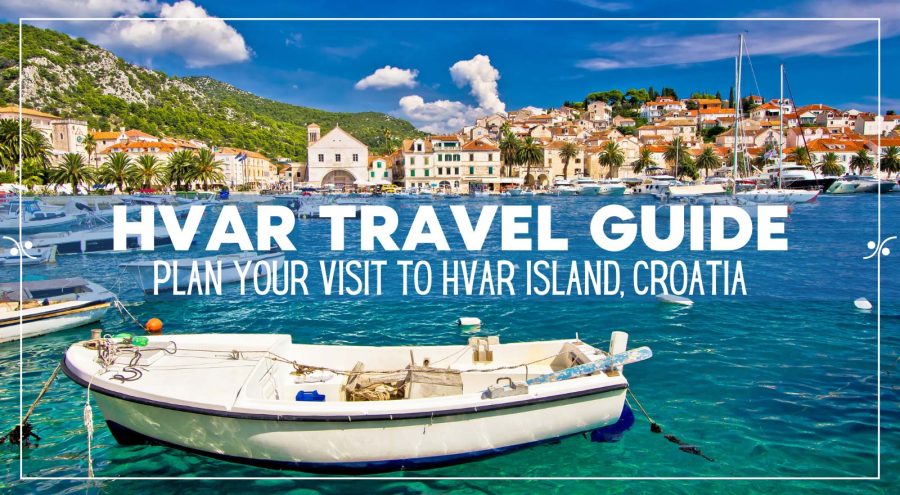
Hvar Island is located in central Dalmatia, off the coast of Makarska Riviera on the mainland, and between the islands of Brac, Vis, Korcula, and Peljesac peninsula.
Hvar Town, Vrboska, Stari Grad, and Jelsa are the most popular towns on the island. Beautiful nature, a good tourist infrastructure, lovely beaches, tons of history, and good nightlife are some of the reasons to visit Hvar. From historical old towns dating back to ancient times to lovely pebbly beaches, and natural beauties, Hvar Island is a wonder to be discovered.
Table of Contents
Map & location
Hvar Island is located in central Dalmatia, off the coast of Makarska Riviera on the mainland, and between the islands of Brac, Vis, Korcula, and Peljesac peninsula.
The island stretches for just over 68 km from northwest to southeast. And, it’s the longest Croatian island.
Hvar Town is the largest settlement on the island and the island’s administrative center.
The northwest part of the island is rich in freshwater springs, and thus fertile, while the rest of the island is rather dry.
Below you’ll find a google map of the island.
Best Time to Visit Hvar Island
The best time to visit Hvar is from June through October.
While July and August are the peak season in entire Croatia, Hvar is particularly crowded and accommodation prices are quite high. The average sea temperature is 25°C / 77°F, and the air temperature is 30°C / 86°F.
If you visit Hvar in June or September, you will be able to enjoy swimming and sunbathing with the sea temperature above 20° / 68°F (the average is usually around 22°-23° / 72°F-73°F) and the average air temperature is around 26° / 79°F.
Hvar Island Travel Guide: Best towns
Hvar Town, Vrboska, Stari Grad, and Jelsa are the most popular towns on Hvar Island. Choosing the best place to stay on Hvar island depends on multiple factors, like how many days you plan to stay here, how budget-minded you are, whether would you travel by car, do you plan on staying in one place, or traveling around, and so on.
If you want to see and be seen and don’t mind paying a premium for that pleasure, choose Hvar Town. Otherwise, choose Vrboska, Stari Grad, or Jelsa if you prefer a quieter, more laid-back vibe that is also lighter on your wallet.
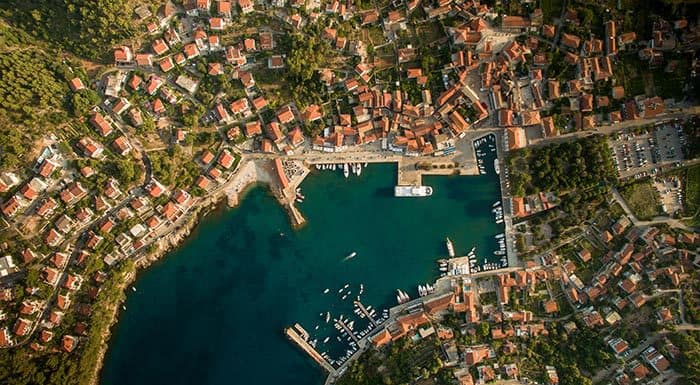
Hvar Town is the largest, best-known, and most-visited town on the island. The most attractive destination on the island, it is also the most expensive place to stay. The town boasts a myriad of beaches, hotels, restaurants, historical buildings, and cultural monuments, as well as the best nightlife on the entire island.
Stari Grad is the oldest settlement on the island. The town is located along the long, deep bay with the old town at its end. The old town consists of traditional stone houses, cobblestone streets, and numerous churches. The most interesting monument is Tvrdalj Castle, a palace from the 16th century. Beaches aren’t Stari Grad’s forte, but nevertheless, it’s a popular summer destination.
Located in the center of the island’s northern shores, Jelsa has lovely beaches (some of them sandy!), a good choice of private accommodation, and a variety of sports facilities, restaurants, and bars. It’s a good alternative to Hvar town for those looking for more affordable accommodations and a quieter vibe.
If you fancy quaint villages, consider Vrboska, Milna, Sveta Nedjelja, or Sućuraj.
Reasons to visit the Island
Hvar is one of the most visited Croatian islands for a reason. It’s stunningly beautiful, with good tourist infrastructure, lovely beaches, tons of history, and good nightlife.
The first thing you’ll notice on the island is its breathtaking nature and the scents of wild herbs filling the air. Island’s beaches are one of a kind, and a great reason to visit Hvar. And so is the island’s rich historical and cultural heritage, including churches, palaces, plains, cobblestone streets and squares, and fortresses. People make places, and one of the reasons to visit Hvar is its warm and friendly people.
Natural beauty
After hearing of so many celebrities visiting the island, you might imagine it all glitz and glamor, but it’s far from the truth. Our number one reason to visit the island is actually its stunning nature.
The island, out of the main tourist resorts, is pretty intact. Wild herbs perfume the air wherever you go. The wild oregano left the deepest impression on us on our last visit here, back in May. We even brought some home and planted them in our garden. Fingers crossed they survive Istrian winter [2021 Update: it didn’t survive – *sad face*].
Beaches
Island’s beaches are one of a kind. And if beach hopping is your kind of vacation, then Hvar might just be the right destination in Croatia to visit.
With a length of 250 km, the island’s coastline offers ample possibilities for swimming, and a wide range of beaches: rocky, pebbly, and even sandy beaches.
And while the island is super-popular, and gets loads of tourists over the summer, you can still find your little (semi)private spot by the sea.
Obviously, this won’t happen on the most popular beaches in and around main towns, like Jelsa, Stari Grad, and Vrboska. But take a drive east, to less popular corners of the island, and you’ll discover many coves, bays, and beaches where very few fellow tourists wander.
Also, the sea here is so clean and has a special glittering color.
History & Culture
Illyrians, Greeks, Romans, Byzantines, Croatians, Venetians, Austrians, French, and Italians, all ruled the island throughout history, and they all left a trace in the island’s architecture, culture, and food.
Agricultural land in Stari Grad plains, UNESCO World Heritage Site, is still divided following the same pattern that the Greeks laid down almost 2500 years ago.
Hvar theatre, constructed in 1612, is one of the oldest theatres in all of Europe.
So, wherever you go on the island, you’ll encounter something of historical value.
Cobblestone streets, centuries-old squares, churches, and palaces dotting major towns and villages on Hvar are all witnesses of the island’s long history.
People
There is a common belief among Croatians, that people living on islands are special. Not in a bad or good way, just simply different than people living on the mainland.
However, for some reason, I found people on Hvar, to fit me perfectly. I found them warm, welcoming, open, funny, and very direct in communication. People make places, and one of the reasons to visit Hvar is its warm and friendly people.
What to see in Hvar, Croatia
From historical old towns dating back to ancient times to beautiful pebbly beaches, and natural wonders, Hvar Island is a wonder to be discovered.
Hvar Town is the most popular town on the island and a must-see place. Dubovica Beach is a lovely cove with clear water perfect for snorkeling. Stari Grad Plain is a historical landmark set by the Greeks in the 4th century BC, and a UNESCO World Heritage Site. An archipelago of twenty-something islands, Pakleni islands are a true wonder of nature and an inevitable stop when in Hvar, Croatia. Established in 384 BC by Greek colonists, Stari grad is one of the oldest continuous settlements in all of Croatia.
Hvar Town
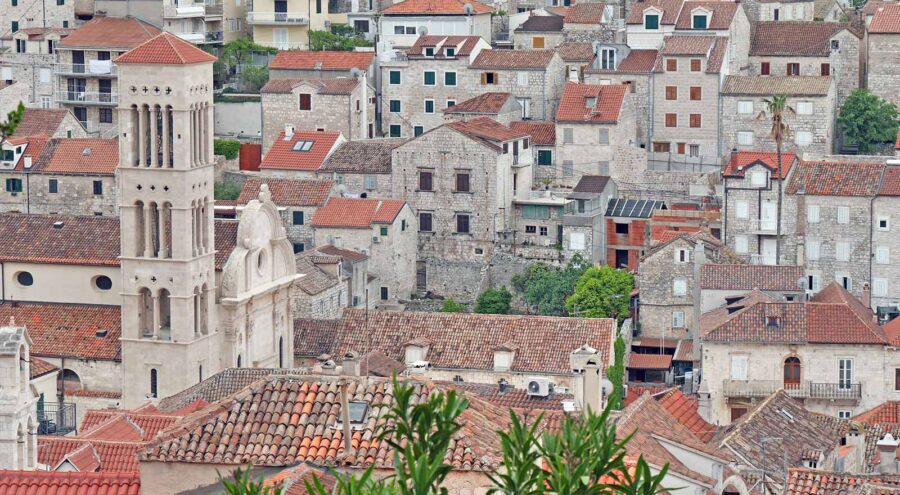
The most popular town on the island, Hvar is simply gorgeous and a must-see on your trip here. Dominated by a large town square that features an Arsenal building, St. Stephen Church, and a small port, the old town is encircled by protective walls from the interior and overlooked by the 16th-century Spanish Fort (Fortica). Today, Fortica is a popular tourist spot, and it offers lovely views over the town, the sea, and the Paklinski Islands. For even better views (and fewer tourists), hike or drive up to Napoljun fortress atop Saint Nicolas hill.
Dubovica Beach
Dubovica Beach is a lovely cove with clear water perfect for snorkeling. This lovely beach is a must-visit! The parking, aside from the main road, is limited, and you need to walk to reach the beach from the road. However, it’s well worth the effort. The beach is secluded, made of small rounded pebbles, and while it is off-the-beaten-path, it still gets quite busy. There are two beach bars/restaurants serving drinks and food. The shade is limited, but dips in clear blue Adriatic should keep you cool. It gets crowded in high season.
Stari grad Plain
Unesco World Heritage Site since 2008, this fertile agricultural land, east of Stari Grad, has been cultivated since ancient times. In fact, it still keeps the same layout, as set by the Greeks in the 4th century BC. Cycle or take a ride through this maze of plots, planted mainly with grapes, olives, and veggies, and divided by dry stone walls.
Pakleni Islands
An archipelago of twenty-something islands, Pakleni islands are a true wonder of nature and inevitable stop when in Hvar, Croatia. The islands are gorgeous, surrounded by turquoise waters, and full of hidden beaches, calm bays, and a few restaurants and bars here and there – a perfect spot to spend a day swimming, snorkeling, kayaking, or just chilling by the sea. The most popular places include Palmižana, located on St. Clement Island, Jerolim Island with its nude beaches, and Marinkovac with the famed Carpe Diem Beach Club.
Stari Grad
Established in 384 BC by Greek colonists, Stari grad is not only the oldest settlement on the island, but one of the oldest continuous settlements in all of Croatia, and even in all of Europe. The old town is lovely, with its rich history, numerous churches, palaces, and cobblestone streets. Don’t miss a visit to the Tvrdalj, a former summer residence of a renaissance poet Petar Hektorovic dating back to the 16th century.
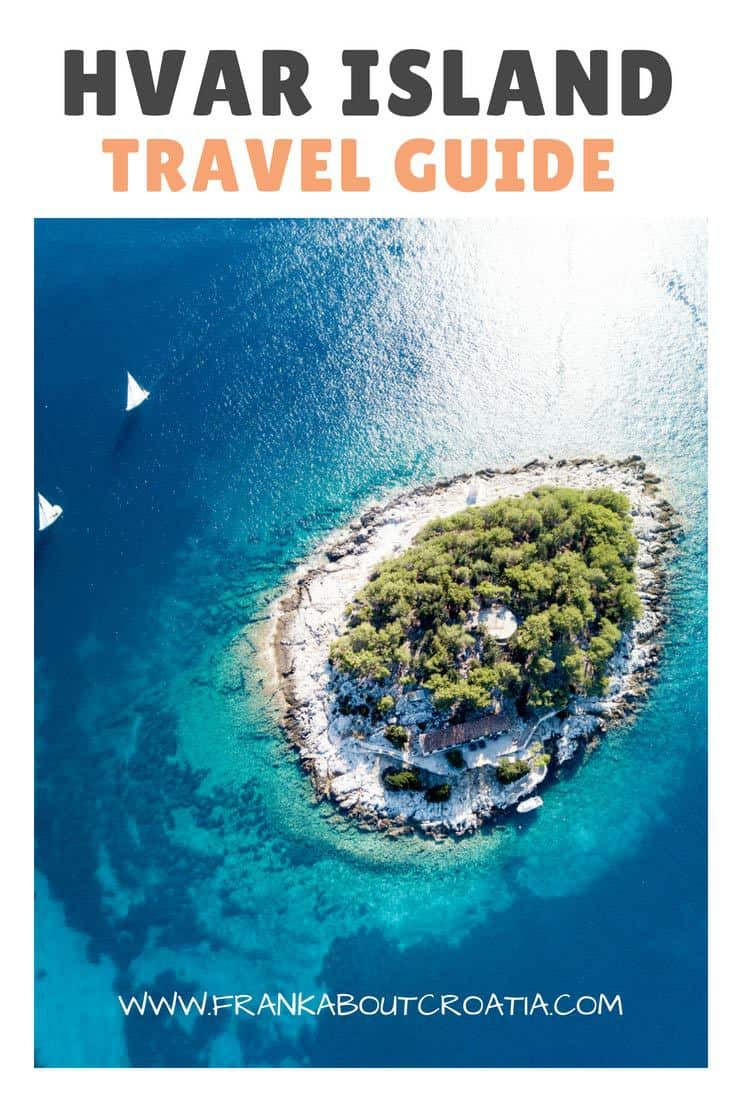
Things to do
The majority of tourists visit Hvar to enjoy water activities including swimming, snorkeling, boating, SUP, kayaking, and other fun-under-the-sun things to do in Hvar. Hvar offers many things to do for curious travelers.
Plan a half-day or full-day wine tour of the island! Take some time to explore abandoned villages in Hvar’s interior. Go hiking and immerse yourself in the scents of rosemary, lavender, and wild oregano. Sample local cuisine!
Wine Tour
There are many ways to get to know Hvar Island and one of them is to get to know it through its wines. Wine has been a major part of the island’s economy and lifestyle ever since ancient Greeks arrived on the island, back in the 4th century BC. And it’s as important today, as it was back then.
Plan a half-day or full-day wine tour of the island! You can easily do it on your own, but we believe having a local guide/driver makes it so much better. A guide can give you an introductory tour, answer all your questions, and best of all, you can indulge in wine tasting all you want as you won’t need to drive. Check out this 3-hour wine-tasting tour!
Popular wine producers are Zlatan Otok, Tomić Wines, PZ Svirce, Plancic Brothers, and others. Popular sorts include red Plavac mali (Zinfandel’s offspring very popular in mid and southern Dalmatia), and pošip, a white grape native to the island of Korcula, but planted now all over southern and central Dalmatia.
Abandoned villages

Like in other Croatian coastal regions, the locals haven’t resided in coastal towns back in the past. Believe it or not, our ancestors preferred the safety, and coziness, of mountainous interiors. They were farmers who lived off livestock, and crops. And the villages developed around fertile interiors.
But first with phylloxera, and later with industrialization and development of the modern-day tourism industry, people started migrating to the coast (or further away), abandoning their old villages, and the old way of life.
Today, these villages, although abandoned, and for a major part uninhabited, still, witness our past. When on the island, take some time to explore some of those villages. Our favorite places include Malo Grablje and Humac.
Chase authentic island scents
I’ve visited many Croatian islands, including Brac, Vis, Korcula, Elafiti, Mljet, Cres, Krk, Lošinj, Murter, Pag, Kornati, and Lastovo, but I have never felt such wonderful scents as I did on Hvar Island. Maybe it was a time of the year we’ve visited that contributed to this (we’ve been there in May when all nature awakens), or it’s really a “Hvar thing”, but I highly recommend everyone visiting the island to take a hike in nature immersed in the scents of rosemary, lavender, and wild oregano.
This small group tour takes you through Hvar’s lavender fields.
Sample local cuisine
Typical dishes here don’t differ much from the rest of Dalmatia, with few exemptions, like gregada, a fish stew typical for Hvar. Island’s dietary pattern is simple: based on boiled veggies, fresh fish, and everything soaked (yes, soaked. not sprinkled) in olive oil. For typical comfort food, head to Kokot in Dol, Stori Komin in Malo Grablje, or tavern Kod None in Svirče.
Sail to Paklinski Islands
A wonderful archipelago just off the coast of Hvar Town, Paklinski Islands are a must-visit natural site on Hvar Island. Explore hidden coves and beaches, hop from one islet to another, stop for a dip in the sea, snorkel, sunbathe, have a picnic, or chill out in one of the beach bars. Paklinski Islands are easy to visit from Hvar, just hop on a taxi boat, rent a kayak, or for the ultimate experience book a half-day sailing tour to Paklinski Islands.
Visit Vis Island and Blue Cave
Croatia has so many islands that it would take a lifetime to properly visit and experience them all. So, if you have a chance to easily visit more than one island while in Croatia, just do it! If you are staying in Hvar for more than a couple of days, visit also Vis and Bisevo’s famed Blue Cave. Many local companies offer a speedboat tour to Vis and Blue Cave. Although a visit to Blue Cave is short, just a couple of minutes, it is well worth a trip. The color of the water is mesmerizing, and it is just an overall amazing feeling to go inside the sea cave. Vis Island, on the other hand, is a wonder on its own, full of hidden coves, small pebbly beaches, amazing food, and historical intrigues.
Accommodation
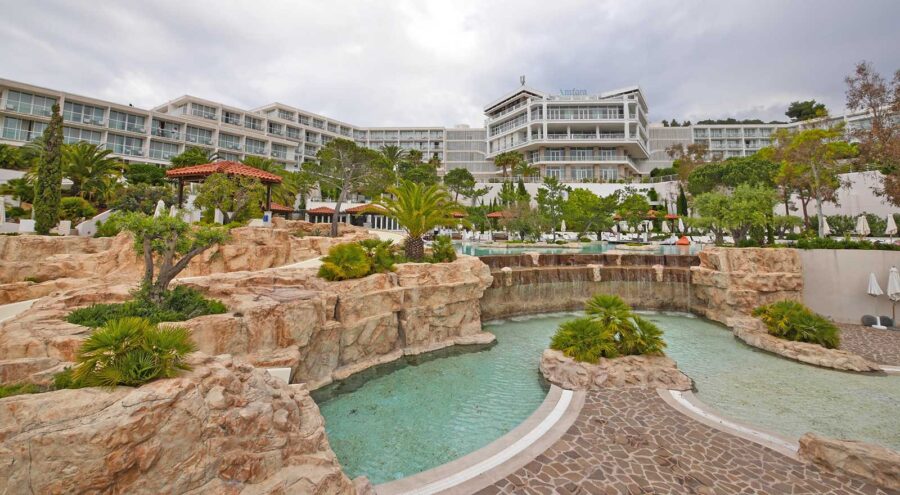
Hvar is a popular tourist destination with good infrastructure and a variety of accommodations: from hotels to private apartments, villas, youth hostels, and even camping.
The main tourist season stretches from late June to early September, with the last week of July, and two weeks of August being the peak season.
Accommodation prices skyrocket at this time. So if you want to stretch your dollar, our suggestion would be to visit the island in the second half of September or early October, when the weather is still nice, the sea is warm enough for swimming, and crowds are fewer.
Another piece of advice we can give you is to book your accommodation as early as possible. Similar to airline tickets, accommodation prices also increase with the demand, as there is less inventory on the market. This means that the earlier you book, the cheaper price you will pay.
The most popular booking site in Croatia is Booking.com. You can search for your accommodation there, as they have the largest inventory for short-term rentals and hotels in Croatia.
If you book using Booking.com, book a room with a flexible cancelation policy. This way, if your plans change, you can simply cancel your booking. Also, if for some reason, at any time, your hotel runs a promotion, you’ll be able to cancel your previous booking and secure a better deal.
For private apartments, besides Booking, check also Airbnb.
Best places to stay
Amfora Grand Beach Resort is the largest hotel on the entire island (330 rooms). Overlooking the sea, and Beach Club Hvar, this 4-star hotel features a large outdoor swimming pool, onsite buffet, a la carte restaurants, a beach, and pool grill and bar, as well as Sensori SPA center. The rooms are a bit dated, and on the smallish side, but nevertheless, they are comfy and clean. Not all rooms feature a balcony, so paying extra for the sea-facing room with the balcony is worth the money. Prices range from 155 € in the low season to 400 € in the peak season.
Adriana Spa Hotel, run by the same hotel company as Amfora, is a small, boutique hotel located in the center of Hvar Town, at the seaside promenade. Hotel Adriana features 62 rooms, and excellent wellness and spa facilities including a seawater rooftop indoor swimming pool. Views from the rooms on higher floors are awesome. Daily prices for a double room with breakfast range from 173 € in April and November to 500 € from June to September.
B&B Heritage Villa Apolon
A lovely B&B Heritage Villa Apolon, housed in a historical villa in Stari Grad, features six rooms, an onsite restaurant, and a wine bar. The rooms are very spacious, well-equipped with all mod cons, and beautifully restored keeping many original elements like wooden beams, exposed stone walls, etc… Expect to pay for a double room with breakfast anywhere between 180 € to 240 € a day.
Villa Riva, a seafront property in Jelsa, features one double room and two studio apartments. Apartments are modern, stylish, and comfy but they still maintain the character of this traditional stone building. Prices start at 95 € per day for a double room.
If you like unique accommodation, Heritage Suites Zanini delivers it! Studio and apartments are housed in a beautiful 15th-century palace. Both, the interior and exterior are wonderful. The units feature a fully-equipped kitchen, living and sleeping area, and a full bathroom. Exposed wooden beams, brick walls, and ceramic floors only add to the Heritage Suites Zanini charm. Prices start from 180 € in the low season to 390 € in the peak season.
Food and Restaurants
If you spent some time here on our blog, you already know that we love food. Whether we eat at top-notch fine dining restaurants or humble local eateries, they all have one thing in common: they use fresh local ingredients to turn them into divine dishes.
We find that on the island of Hvar, your best bet when it comes to food is to go with traditional-dishes, and more often than not to look for traditional eateries called “konoba”; this means grilled fish, and meat with side dishes like Swiss chard, zucchini fritters, or French fries; octopus or meat with veggies, baked in a pot covered with embers, called peka; gregada, a typical fish stew from the island.
Below you’ll find a few recommended restaurants, and more to follow in a separate blog post.
Must-try restaurants
Konoba Kokot, Dol: This family-run tavern is best-known for meat dishes, particularly for lamb meat. It’s a place to try peka, one of the most popular dishes in Croatia. But also don’t miss on yummy goat cheese made by the owner’s mum.
Stori komin, Malo Grablje: tucked away at the edge of the abandoned village of Malo grablje, Stori komin is a great place to unwind, and taste traditional Dalmatian comfort food. You can hike there, or take a small road from the village of Milna to reach Malo grablje. The food is honest, well-prepared, and tasty. Try their veal and lamb chops.
Konoba Vrisnik, Vrisnik: This family-run tavern is one of our favorite places to eat on the island. The food is authentic, freshly made, and super tasty, and the service at this local tavern is superb. Here, people come for grilled fish and meat, but also for some old island’s dishes that you can hardly find anywhere else anymore. Vrisnik, along with the neighboring villages of Vrbanj and Pitve, is also the home of some good Hvar wineries. Combine a visit to the tavern tavern Vrisnik with a visit to a couple of local wineries like PZ-Svirce, or Plancic Winery.
Oaza in Milna: Just a stone’s throw away from the beach, Oaza is a true gem meant for hedonists. The food is always fresh, tasty, and the restaurants offer great value for money. They serve anything made on a wood-burning grill, from meat, fish, and seafood, to yummy veggies soaked in olive oil. Love their zucchini fritters!
Konoba Zbondini, Velo Grablje: Once the center of rosemary and lavender production on the island, Velo Grablje today is almost completely abandoned. However, a few years ago Tudor family returned to the village to open konoba Zbondini. This lovely tavern with rustic interiors and a breezy terrace offer traditional Dalmatian dishes prepared using only fresh, local ingredients.
Where to find the best beaches
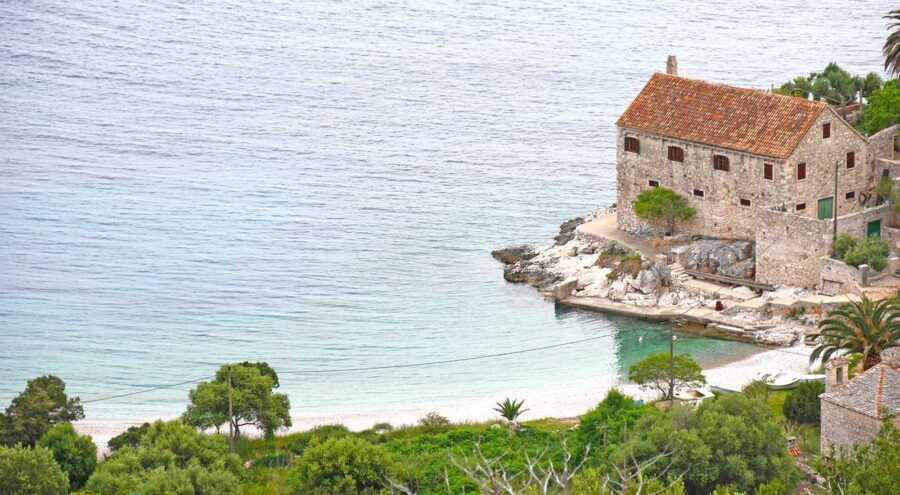
When I think of Hvar, I can’t but think of the gorgeous sea, limpid, and calm, with lovely turquoise colors that simply draw you in to take a few laps or to just float endlessly.
Gromin Dolac, Jagodna, Mekicevica, Pokonji Dol, Zecja, Veliki Pokrivenik, Dubovica, Ivan Dolac, and Vela Stiniva might sound incomprehensible to you, but they are some of the most beautiful beaches on the island, and you better learn these names fast.
Just like elsewhere in Croatia, Hvar beaches are mostly rocky, and pebbly. The nicest secluded bays take a boat ride to reach or a walk in the heat, but they are all worth it.
The southern side of the island is home to some of the best beaches on Hvar island. South-east of Hvar Town, the steep shores of Zaraće, Sveta Nedilja, Ivan Dolac, and Gromin Dolac, all abound in lovely pebbly beaches; some with pebbles so tiny that they almost feel like sand.
Pakleni Islands consists of many small islands and lovely bays that make for favorite swimming spots among locals and tourists alike.
Hopeless sand beach enthusiasts head either to Jelsa or to Sucuraj. Both towns have sandy beaches in the vicinity.
Bars, Clubs & Nightlife
The island has an infamous reputation for offering a restless, fun, crowded, and wild nightlife. In reality, this only happens in Hvar Town. And it only happens in the high season.
Carpe Diem, Hula Hula, Kiva, and Ka’Lavanda all offer day and night partying, cocktails, DJs, and good vibes. They are also all pricey. Many Hvar beach clubs are popular spots for after-beach parties.
And if your ideal holidays don’t include a load of the loud, overexcited alcohol-infused twenty-something years old, head somewhere else on the island like Jelsa or Stari Grad.
Traveling to Hvar Island
Split and Dubrovnik airports are the closest airports to Hvar island. However, regardless of the way you travel to and around Croatia, sooner or later you’ll need to board a ferry or catamaran, or just a boat, to reach the island.
If you travel to Hvar from other parts of Croatia, like Zagreb, Istria, or Zadar, you’ll need first to reach Split, Drvenik, or Dubrovnik to catch the ferry for the island.
And finally, you can book a private or shared boat transfer. For more information check the Bookaway or Get Your Guide.
From Split
The easiest way to reach Hvar Island is from Split. The Split ferry port is conveniently located just across the bus station, a few minutes walk from the old town. Three ferry companies connect Split with Hvar Island by ferry and fast-speed catamarans: Jadrolinija, Kapetan Luka, and TP Line. A car ferry, operated by Jadrolinija, sails exclusively from Split to Stari Grad on Hvar Island, and the journey takes approximately 2 hours. Fast-speed catamarans connect Split with Hvar Town, and the journey lasts around 50 minutes. You can check availability and book your tickets online here.
We have the complete guide on how to reach Hvar from Split!
A Day Tour from Split to Hvar
Many readers ask us if it’s worth taking a day tour from Split to Hvar. The answer is Yes! You can do it on your own, especially from June through September when there are many ferry crossings between the two throughout the day. However, it might just be easier and more convenient to book a small group tour from Split. Below you can find a few boat tours that we recommend.
From Dubrovnik
In high season Dubrovnik serves as one of the main gateways to Hvar Island. The best way to reach Hvar from Dubrovnik is by catamaran that runs daily from April through October.
Catamarans are operated by Jadrolinija and Kapetan Luka companies, and each has a slightly different route.
Jadrolinija’s catamaran runs daily from the second week of June to the last week of September. It departs from Dubrovnik at 7 am and arrives at Hvar at 10.30 pm. It also stops in Korcula, and after Hvar, it continues to Bol on Brac Island, and further to Split. The return trip departs from Hvar at 5.55 pm and arrives in Dubrovnik at 9.25 pm. A one-way ticket costs 45 € per person.
Kapetan Luka’s catamaran runs daily from April through October. It departs from Dubrovnik at 4.15 pm (Sept., Oct.: 4 pm) and arrives in Hvar at 7.30 pm (Sept., Oct.: 7.10 pm). This catamaran also stops in Pomena on the island of Mljet, and Korcula before arriving at Hvar, and then continues further to Milna on the island of Brac, and Split. The boat leaves Hvar for Dubrovnik at 8.40 am, and it arrives in Dubrovnik at 11.55 pm. A one-way ticket costs 45 € per person. You can book a seat online here!
From other places
Car-ferry also connects Sucuraj on the island with Drvenik near Makarska, Croatia. A car ferry runs 6 times a day in winter and as many as 11 times a day in summer. Sucuraj is at the far end of the island compared with other towns. Jelsa is approx. 50 km away from Sucuraj, and Hvar Town is almost 80 km away.
However, a ferry crossing from the mainland takes only 35 minutes (compared with 120 minutes from Split to Stari Grad). A one-way ticket costs 3.99 € per adult and 18.96 € for a car.
Besides the mainland, you can also reach the Hvar from other islands, including Brac, Korcula, Lastovo, Mljet, and Vis Island. However, island hopping within one day is rarely done. If you plan to hop from one to another island, plan to spend at least an overnight in each of them.
The only international ferry line serving the island of Hvar is one from Ancona in Italy to Stari Grad. It’s an overnight ferry that runs year-round from Split to Ancona, but the stop in Stari Grad is only scheduled during the first two weeks of August.
Getting around
The most convenient way to travel around the island is by car, or by scooter. The main island’s road D116 runs from Hvar Town to Sucuraj and connects all major towns on the island, like Stari Grad, Jelsa, and Vrboska.
The western section of this road, around Hvar, Jelsa, and Stari Grad, is in good condition. However the more east you go toward Sucuraj the worse it gets. It becomes narrow, with patched asphalt at many places, a lack of safety barriers, and some curves especially once you pass Jelsa.
If you travel by car from the mainland, make sure you fill up gas prior to crossing onto the island. The island disposes of just three gas stations for motor vehicles: one in Hvar Town, and two in and out of Jelsa.
Another way to travel around the island is by bus. The island is served by Cazmatrans (t: +385 21 765 904), one of the national bus operators (don’t bother trying to book through their website, or just trying to retrieve the bus timetable – it simply doesn’t work). Buses connect all major towns on the island (Jelsa, Vrboska, Stari Grad, Stari Grad ferry terminal, Hvar, Sucuraj). Unfortunately, Cazmatrans doesn’t sell tickets through the GetByBus website, but it’s still a good place to check the bus schedule. You can also check the updated bus schedule in the image below.

Car Rental
There are a few things to consider if you plan to use a rental car on the island. The main consideration is whether should you rent a car on the island, or on the mainland, prior to crossing over. This decision is not always evident, and more often than not it depends on personal preferences.
Car rental in Split Airport, or elsewhere on the mainland, can provide you with a better choice of cars to hire, cheaper rental prices, and an overall better supply of rental cars.
On the other hand, hiring a car on the island gives you the opportunity to rent only for the days you will actually use it (even if the price per day comes as more expensive; you will perhaps still spend less money in total on car rental).
It also gives you a chance to skip the lines on ferries. Queues on ferries only form for the cars, and sometimes you are so far away in a queue that you need to wait for the next car ferry. This never happens if you cross on foot to the island.
Crossing to the island on foot will also give you a chance to travel directly to Hvar Town, as car ferries don’t dock in Hvar Town, only in Stari Grad or Sucuraj. Passenger-only catamarans dock in downtown Hvar Town.
Also, worth mentioning is the fact that the majority of car rental companies in Croatia will charge you a one-time fee for taking a car on ferries.
The downside of renting a car on the island is the shortage of available vehicles in the high season. Make sure to book your car on time and well in advance.
Further Reading
Paul Bradbury’s Hvar: An Insider’s Guide is perhaps the best travel book about Hvar. You can also check his other book about his life on the island entitled Lavender, Dormice, and a Donkey Named Mercedes: A Decade of Expat Living on Hvar
If you plan to visit more than Hvar while in Croatia, we highly recommend Fodor’s Essential Croatia, and Lonely Planet Croatia travel guides.
If you plan to make a trip to neighboring Brac Island, read our Brac Island Travel Guide
We’ve also written a full post on Things to do on Brac island.
Since you’ll sooner and later end up in Split if going to Hvar, you can also check our Split Travel Guide.
Hope you’ve found someone, Akshata! We aren’t licensed guides.
Hi Frank,
I am looking for a local guide who can show me around Hvar Town for a group of 40 people.
Can you please contact on the email
We are in the throws of planning a trip to Croatia in September 2022 and your website and guides have been invaluable :)
After several days in Dubrovnik, we are staying on Hvar in Old Town. Considering renting a car in Dub and driving to Drvenik, crossing with the car on the ferry, then driving from Sucuraj to Old Town.
Just wondering if there are any current updates on the road conditions between Sucuraj and Old Town?
So excited to go!!! Any thoughts would be greatly appreciated :)
Please read our post on visiting Croatia during Covid: https://www.frankaboutcroatia.com/visiting-croatia-during-covid-19-pandemic/
We have explained everything there.
Hi, I am hoping for a bit of current advice. Im planning a stag do for my friend for a long weekend in September. We are travelling from England, and there are 16 of us. With regards to COVID, what is the current situation for attending nightclubs? I have seen all the festivals in Pag island have been cancelled but couldn’t find any specific information for anywhere else. Also with us being such a large group are we likely to struggle with entry into bars and clubs? Finally, the group is interested in r&b music but a lot of the clubs are advertised with house/techno music – is there any city you’d recommend for that kind of music? I apologise for so many specific questions, I am struggling to find any information on this anywhere.
Many thanks
You can take a rental car with you on the ferry. Make sure to mention this when renting a car as you are supposed to pay an extra insurance for the ferry transfer.
Hello! Me and my friends are travelling to Croatia this month. We are buying the ferry tickets to go from Split to Hvar, but we can’t find the option to take our rental car with us (we saw some people doing this in several vlogs). I don’t know if you know any information about this!
Thank you for your attention and help!
Leonor
Hi Victoriya,
hm, you can do it both ways, crossing over to Hvar with a car, or without.
It all depends what you want to do. Having a car on the island gives you opportunity to visit places beyond main port city (Hvar Town in your case, I suppose). You can discover all major villages on the island, visit hidden beaches, and visit the interior of the island (and eat in some traditional taverns like ones in Dol). Many hotels and private accommodation have parkings, some
don’t. Check before booking.
If you decide to travel with the car all the time then I wouldn’t take the ferry from Hvar to Dubrovnik. Instead I would go back to mainland and take a coastal road from Drvenik to Dubrovnik. It’s really nice and scenic.
You can book tickets online on Jadrolinija website.
Hi. I am planning a trip to Croatia for group of 4, Can you suggest please. We will have a rental car and will arrive to Split by car. the next we plan visit Hvar for 2 days, and then Dubrovnik and Mostar and Montenegro. The questions is: Should we return the car in Split, and take Ferry to Hvar, and then to Dubrovnik, OR better to keep car and take a Ferry with car to Stari Grad at Hvar, use the car in HVAR (do we need car in Hvar) , and then take Ferry with car to Dubrovnik ?
A
1.If we take a car to Hvar , what we going to use it for, do Hotels have parkings. and how to take car back to Dubrovnik?
2. How to plan and book tickets for Ferry , September 26. for 4 people and car, and how much it will cost, and the same thing September 28, to Dubrovnik?
B if we return the car in Split, how we will be able to explore HVAR , and we would need to rent car again in Dubrovnik to travel Montenegro.
Appreciate your response.
yes, there are taxis on the island. It is more expensive than in bigger towns. You can check http://www.hvartaxi.com/.
Is there a taxi on the island?
I’ve been to Island Hvar, Stari Grad this summer. It was just amazing! (This was my second time to visit Stari Grad)
Beautiful place for charging your batteries. people are great, Croatian cuisine also and everything feels just astonishing and beautiful, There is Maslinica sand beach and we went there every day for swimming, diving and relaxing. Water is crystal clear and at the entrance, there is a lot of little natural sources of water so the water feels little cold first 10 steps but when you get in, it is real refreshment. I will definitely visit Hvar, Stari Grad again! I can write about it till tomorrow and will not be able to express myself how great it is.